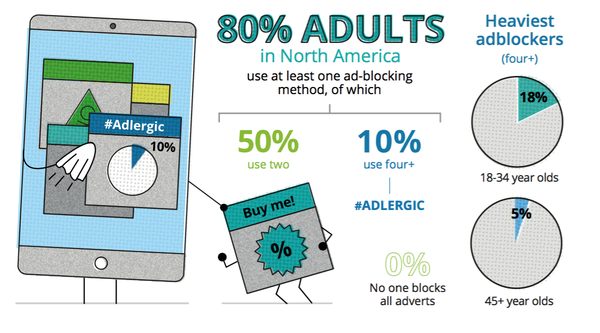research
Deloitte Predicts Increased Reliance On Technology
- by Tanya Gazdik , December 12, 2017

Three-quarters of North Americans engage in at least one form of regular adblocking, and about 10% of this population engages in blocking ads in four or more ways — the “adlergic” population, according to Deloitte. Consumers who are young, highly educated, employed, and have higher incomes are more likely to be heavy adblockers.
Many industries will continue to be impacted by technology, media and telecommunications advances, according to the 17th edition of the "Technology, Media & Telecommunications Predictions.” The report provides an outlook on key trends over the course of the next one to five years in the technology, media and telecommunications industry sectors worldwide.
“This year’s predictions underscore the stunning momentum we see across the technology, media and telecommunications sectors,” says Sandra Shirai, vice chairman, Deloitte LLP, and U.S. technology, media and telecommunications leader, in a release. “While we’ll see exponential growth in some areas, we see consumer behavior maturing in others. This will drive a next wave of innovation which will have a profound impact on both enterprises and consumers in 2018.”
advertisement
advertisement
One-fifth of North American homes will get all of their internet data access via cellular mobile networks in 2018. There will be significant variations worldwide by country, however. In Brazil, for example, nearly a third of all homes will be mobile only, but only 10% in some European countries. The differences between geographies are due to a range of technological, economic and demographic factors.
Deloitte predicts that live broadcast and events will generate over $545 billion in direct revenues in 2018. Despite consumers’ capability to consume content on demand or attend events remotely, live consumption is thriving.
By 2020, there will likely be over 680 million digital subscriptions, with consumers increasingly willing to pay for content. China will likely remain the largest market for livestreaming at $4.4 billion in 2018, an 86% increase from 2016.
In many cases, live content’s performance has been made more productive and profitable by digital. This indicates an increasing willingness from consumers to pay for digital content. Deloitte also predicts that by the end of 2018, 50% of adults in developed countries will have at least two online-only media subscriptions, and by the end of 2020, the average will have doubled to four.
“The massive consumer interest in streaming, mobile, on-demand services and personalization are significant opportunities in 2018 for both content creators and brands. We see signs that consumers’ willingness to pay for this content will continue to accelerate in 2018 and beyond,” said Kevin Westcott, vice chairman, Deloitte LLP, and U.S. media and entertainment leader.
One billion passenger airline journeys, or one-quarter of all passengers, are expected to be on planes fitted with in-flight connectivity in 2018, according to Deloitte. This is an estimated 20% increase from projected 2017 totals, generating in-flight connectivity revenue close to $1 billion for 2018.
Smartphone adoption continues to grow. Smartphone sales expected to reach 1.85 billion per year by 2023, equivalent to over 5 million units sold per day. By the end of 2023, more than 90% of adults in developed countries are expected to have a smartphone, with ownership among 55-75 year olds reaching 85%. Deloitte predicts that owners will interact with their phones on average 65 times per day in 2023, a 20% increase on 2018. Over a billion smartphone users will create augmented reality content at least once in 2018, with at least 300 million doing so monthly.
At the same time, Deloitte predicts 45% of global adult smartphone users and 65% of 18-24 year olds will worry that they are using their phones too much for certain activities and may try to limit their usage in 2018.
Notably, TV viewing by 18-24 year olds also will decline by 4-11% per year in the U.S., Canada, and the UK in 2018 and 2019. This rate of decline has been steady for seven years.
“While traditional mobile services have matured in 2017, the opportunities presented by made-for-mobile content, IoT services, wearables and virtual reality represent a significant value proposition to both industry and consumers in 2018 ,” said Craig Wigginton, vice chairman and telecommunications sector leader, Deloitte & Touche LLP, in a release. “The incredible connection between the mobile ecosystem and consumers shows every sign of accelerating in the year ahead.”
The most important key area is the growth in new semiconductor chips that will increase the use of machine learning, enabling applications to use less power, and at the same time become more responsive, flexible and capable.
“We have reached the tipping point where adoption of machine learning in the enterprise is poised to accelerate, and will drive improved business operations, better decision making and provide enhanced or entirely new products and services,” said Paul Sallomi, vice chairman, Deloitte LLP, global TMT industry leader and U.S. technology sector leader, in a release.




